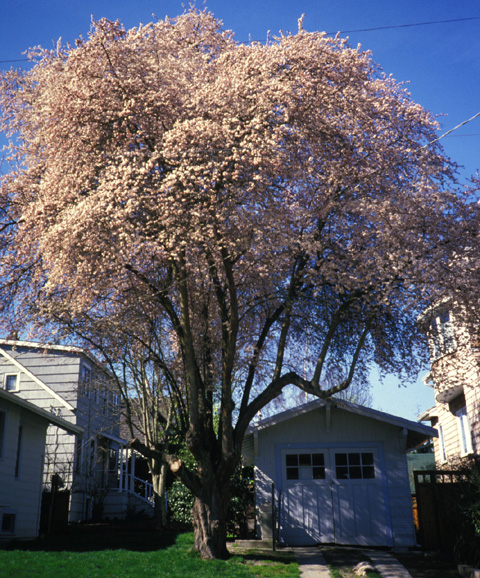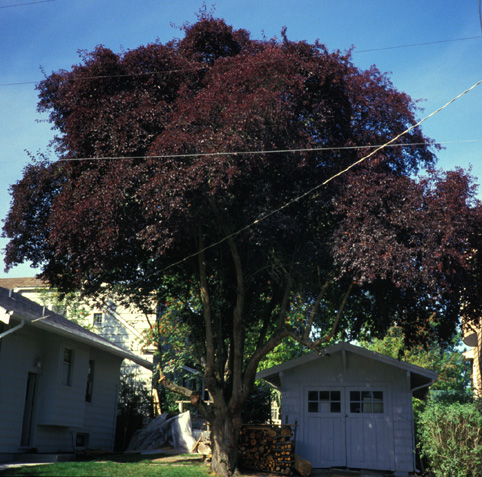
|

|
Purpleleaf Plums on the West Coast
|
| Hundreds of thousands of purpleleaf plums darken our Northwest landscape. The original, Prunus cerasifera 'Pissardii' (syn 'Atropurpurea'), was here before the turn of the century. Over a dozen descendent cultivars have since been planted. Whether we view these somber-hued trees as depressingly dark, or refreshingly different, we remain stuck with the fact that the purpleleaf clan is surprisingly confused and poorly known despite having such a prominent role in our planted landscape. |
| I didn't know this until I tried learning the different cultivars in order to describe them in my Seattle tree guidebook. Now, appreciating the differences between the various clones, and having discovered how interesting a history some kinds have, it is my pleasure to shed some light onto these dark trees for PlantSource readers. Those of you who would prefer to set a torch to such trees, kindly forbear. |
The simplest way to treat the 16 cultivars is alphabetically. Note that while all have Prunus cerasifera "blood" in their background, they are not all cultivars of this species; 10 of the 16 are hybrids, as indicated by the x sign.
|
DESCRIPTIONS
|
ALLRED arose in Arkansas as a 'Pissardii' seedling and was introduced to the nursery trade in 1941. It is still in the Southern U.S. and California nurseries, but I have no records of Northwest nurseries offering it. It is indeed red in early spring, with white flowers, but by May it takes on a bronzy-green color, with its abundant red plums making a handsome contrast in the summer.
|
BIG CIS (x) is a treelike sport of 'Cistena' introduced in 1981 by J. Frank Schmidt & Son Nursery, of Boring, Oregon. Plant Patent No. 5003. See the Schmidt catalog for details.
|
BLIREIANA (x) dates from 1895 in a small French town called La Croix. It is a hybrid between 'Pissardii' and the 'Alphandii' (double, red-flowered) Japanese Apricot. It is well known and popular. The double, bright pink, fragrant flowers are very early. The leaves in summer are a dull, motley mix of green (old ones), bronze, and red (young growth). The tree is dwarf, congested, warty. It very rarely sets plums, which are lightly fuzzy.
|
CISTENA (x) is a well known 1910 hybrid of 'Pissardii' and Prunus Besseyi that arose in South Dakota. It is an exceedingly hardy (zone 2 or 3) shrub, has enchanting flowers, and small leaves of pleasing color. Unfortunately it does poorly west of the Cascades. It is sometimes trained into standard tree form, and 'Big Cis' is an even better treelike selection.
|
HOLLYWOOD (x) is a California hybrid, decades old, that is almost nonexistent in the Northwest; most of the trees sold under its name are really 'Trailblazer'. Authentic 'Hollywood' produces round plums with deep red flesh, ripe in the last week of June or in early to mid-July. It is a vigorous tree with large, white, fragrant flowers quite like those of 'Pissardii'. The leaves are huge and bronzy. It is a valuable fruit producer.
|
KRAUTER'S VESUVIUS was a seedling Prunus cerasifera selected by Carl Krauter of Bakersfield, California, and introduced in 1957. Now common, it looks the world like 'Thundercloud' (i.e., with deep purple leaves, pink flowers) but is more drought-tolerant and so better suited to Southwest conditions.
|
MOSERI (x) was named after M. Moser, nurseryman at Versailles. It has been sold in past years as Pale Pink Blireiana and that is perfectly true of its flowers. It is like 'Blireiana' but larger, less dense, with paler flowers, and slightly larger leaves. Unlike 'Blireiana' it can surpass 20 feet in height and width, and make a trunk fully 1 foot thick. Now apparently out of the nursery trade, it could once be purchased as Prunus Pissardii Veitchii.
|
MT. ST. HELENS (x) is an improved sport of 'Newport' introduced in 1981 by J. Frank Schmidt & Son Nursery, of Boring, Oregon. Plant Patent No. 4987. See the Schmidt catalog for details.
|
NEWPORT (x) is a hybrid of 'Pissardii' and the complex hybrid 'Omaha' (three species in its background). From Minnesota, it was put into commerce in 1923, and has been widely sold. Of all purpleleaf plums, it may have the most attractive natural branching pattern, with a strong horizontal tendency, in delightful contrast to the usual overcharged vertical aspirations of Prunus cerasifera stock. It is also super hardy (zone 3 or 4). The leaf color is good. But it is one of the weakest bloomers. It flowers late in spring and the blossoms are small and do not present a bright display. The tree can reach 23 feet in height and up to 35 feet in width. It almost never ripens fruit here.
|
NIGRA is sold in British Columbia, but has scarcely been tried in the United States (except when we've run-out of 'Thundercloud' and 'Krauter's Vesuvius'). It is intensely dark, has pink flowers, and seems to be more compact and not as vigorous as Thundercloud' and 'Krauter's Vesuvius' --probably it is thus better suited than those two for use under street-wires.
|
PISSARDII started this whole mess. About 1880, the French head gardener (M. Pissard) to the Shah of Persia, sent to France the first purpleleaf plum. It had white flowers. To this clone (also called 'Atropurpurea') all the other kinds are directly or indirectly descended. It is common. One in Seattle is 47.5 feet tall and 58 feet wide! One in Tacoma has a trunk over 8 feet in circumference. One in Victoria has a trunk 9 feet around, and is 50 feet wide.
|
PURPLE PONY or DWARF PURPLE PONY is a 'Krauter's Vesuvius' seedling from California, dating from the early 1960s. Just like 'Nigra' and 'Thundercloud' and 'Krauter's Vesuvius' it has pink flowers and dark leaves, but is claimed by the L.E. Cooke Nursery of Visalia, to be a natural dwarf and absolutely sterile. It has been sparingly planted in the Northwest and deserves more extensive trial to confirm its fruitlessness and dwarfhood.
|
SPENCER HOLLYWOOD (x) was introduced by the Samuel J. Rich Nursery of Hillsboro, Oregon, in 1970 or earlier. It is a natural dwarf, with pretty pink flowers, fragrant, and desirable leaf color, and bears attractive, big, delicious plums. What more do you want? Why is this outstanding tree so extremely rare!?
|
THUNDERCLOUD is the most often sold. There are too many in fact; let us plant something else for a change. It is quite like 'Pissardii' in its form and huge size, but differs in its pink flowers which open a week or so later in spring. Its plums are always red-fleshed while those of some 'Pissardii' trees are yellow-fleshed. It was introduced by Luther Burbank of Santa Rosa, California, in 1919.
|
TRAILBLAZER (x) was originally called 'Oregon Trail'. It is a hybrid seedling of 'Pissardii' and a Japanese plum (reportedly 'Shiro'), and came up in a Portland garden. It was patented and put into commerce in 1955. Alas, it is usually sold as 'Hollywood'! It differs from the real 'Hollywood' in being a weaker, smaller tree, with daintier flowers appearing later in spring, with smaller leaves, and in ripening its egg-shaped plums whose flesh is the color of pink lemonade, from late July into August. It is ornamental and a useful fruit tree.
|
VESUVIUS (x) is a Burbank hybrid, first offered in 1907. Its parentage is unknown. Miserly in its scantily-produced white blossoms, it is worthless as a flowering tree. However, its elm-like or fountain form of growth, small size, and rich color, make it a worthy ornamental foliage tree. I have never found fruit in Seattle, but am assured it ripens good crops in California. Indeed, Northwest nurseries have sold very few specimens, and I know of no very old ones. It has glossy leaves which are frequently puckered and with their edges rolled inwards, making an aspect like that of peach tree foliage. It must be mentioned that several trees have been wrongly sold as 'Vesuvius' for decades. The real thing seems to be the 'Stribling Thundercloud' from Stribling's Nursery of Merced, California.
|
Other kinds of purpleleaf plums may also be found. For years the Stark Bro's Nursery of Missouri offered through its mail-order catalog Luther Burbank's 'Purple Flame'; and the now defunct Bountiful Ridge Nursery of Maryland similarly offered a hybrid called 'Cocheco' over a decade ago. 'Othello' and 'Purpleleaf Kelsey' are other Burbank introductions, which I suppose exist, somewhere. There are also some Old World and Down Under selections which we are lacking. However, there are more than a few of us who are of the opinion that we already have more than enough purpleleaf plums.
|
(Originally published in PlantSource July 1989, pages 5-7)
Back |
|
|

